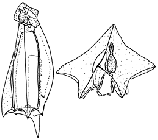WoRMS taxon details
Abylidae L. Agassiz, 1862
135336 (urn:lsid:marinespecies.org:taxname:135336)
accepted
Family
- Subfamily Abylinae L. Agassiz, 1862
- Genus Abyla Quoy & Gaimard, 1827
- Genus Ceratocymba Chun, 1888
- Genus Amphiroa Blainville, 1830 accepted as Abyla Quoy & Gaimard, 1827
- Genus Cymba Quoy & Gaimard, 1827 accepted as Ceratocymba Chun, 1888 (invalid junior homonym of Cymba Sowerby, 1826 [Mollusca])
- Genus Diphyabyla Lens & van Riemsdijk, 1908 accepted as Ceratocymba Chun, 1888
- Genus Nacella Blainville, 1830 accepted as Ceratocymba Chun, 1888 (invalid junior homonym of Nacella Schumacher, 1817 [Mollusca])
- Genus Nacelle Blainville, 1830 accepted as Ceratocymba Chun, 1888 (French version of Cymba)
- Genus Pseudabyla Sears, 1953 accepted as Abyla Quoy & Gaimard, 1827 (based on two aberrant anterior nectophores that might come from an Abyla specimen, or might not, but whichever is the case, they have never been found again)
- Genus Pseudocymba Sears, 1953 accepted as Ceratocymba Chun, 1888 (Based on aberrant pathological anterior nectophores with either two few facets or some missing or incomplete ridges; they could perhaps have come from Ceratocymba specimens, but such nectophores have never been found again)
- Subfamily Abylopsinae Totton, 1954
- Genus Abylopsis Chun, 1888
- Genus Bassia L. Agassiz, 1862
- Genus Enneagonum Quoy & Gaimard, 1827
- Genus Abylopsoides Sears, 1953 accepted as Abylopsis Chun, 1888 (based on four abberrant pathological anterior nectophores never found again)
- Genus Aglaisma Eschscholtz, 1829 accepted as Abylopsis Chun, 1888
- Genus Aglaismoides Huxley, 1859 accepted as Abylopsis Chun, 1888
- Genus Aglaja Eschscholtz, 1825 accepted as Abylopsis Chun, 1888 (invalid junior homonym of Aglaja Renier, 1807 [Mollusca])
- Genus Calpe Quoy & Gaimard, 1827 accepted as Abylopsis Chun, 1888 ( preoccupied by Calpe Treitschke 1825 [Lepidoptera])
- Genus Chunia Mayer, 1900 accepted as Abylopsis Chun, 1888
- Genus Cuboides Quoy & Gaimard, 1827 accepted as Enneagonum Quoy & Gaimard, 1827 (synonym)
- Genus Halopyramis Chun, 1888 accepted as Enneagonum Quoy & Gaimard, 1827 (synonym)
- Genus Parasphenoides Bedot, 1896 accepted as Bassia L. Agassiz, 1862 (unaccepted > junior subjective synonym)
- Genus Plethosoma Lesson, 1826 accepted as Abylopsis Chun, 1888 (unaccepted > junior subjective synonym)
- Genus Pseudabylopsis Sears, 1953 accepted as Abylopsis Chun, 1888 (an aberrant pathological anterior nectophore, perhaps from a specimen of Abylopsis; never found again)
- Genus Pyramis Otto, 1823 accepted as Abylopsis Chun, 1888 (preoccupied by Pyramis Bolten 1798 [Mollusca])
- Genus Sphenoides Huxley, 1859 accepted as Bassia L. Agassiz, 1862
marine, brackish, fresh, terrestrial
recent only
Agassiz, L. (1862). Contributions to the natural history of the United States of America. <em>Little Brown, Boston.</em> 4: 1-380, pls 1-19., available online at https://www.biodiversitylibrary.org/page/16068829
page(s): 372 [details]
page(s): 372 [details]
Schuchert, P.; Choong, H.; Galea, H.; Hoeksema, B.; Lindsay, D.; Manko, M.; Pica, D. (2025). World Hydrozoa Database. Abylidae L. Agassiz, 1862. Accessed through: World Register of Marine Species at: https://www.marinespecies.org/aphia.php?p=taxdetails&id=135336 on 2025-07-15
Date
action
by
![]() The webpage text is licensed under a Creative Commons
Attribution 4.0 License
The webpage text is licensed under a Creative Commons
Attribution 4.0 License
Nomenclature
original description
Agassiz, L. (1862). Contributions to the natural history of the United States of America. <em>Little Brown, Boston.</em> 4: 1-380, pls 1-19., available online at https://www.biodiversitylibrary.org/page/16068829
page(s): 372 [details]
page(s): 372 [details]
Taxonomy
redescription
Sears, M. (1953). Notes on siphonophores. 2. A revision of the Abylinae. <em>Bulletin of the Museum of comparative Zoölogy of Harvard College.</em> 109: 1-119., available online at https://www.biodiversitylibrary.org/page/3886008 [details]
Other
 Present
Present  Inaccurate
Inaccurate  Introduced: alien
Introduced: alien  Containing type locality
Containing type locality
From editor or global species database
Diagnosis Calycophorae which develop a temporary larval bract before the larval nectophore, the latter is retained in the polygastric stage as the anterior nectophore. All but one species develop a second (definitive) nectophore, the posterior one, which is usually considerably larger than the anterior one and does not possess a somatocyst. The nectophores are ridged and angular, the posterior one usually bearing serrated ridges and teeth. The hydroecium of the anterior nectophore is an enclosed tube opening basally. [details]
| Language | Name | |
|---|---|---|
| Japanese | ハコクラゲ科 | [details] |

